Simon Benninga. Financial Modelling 3-rd edition
Подождите немного. Документ загружается.

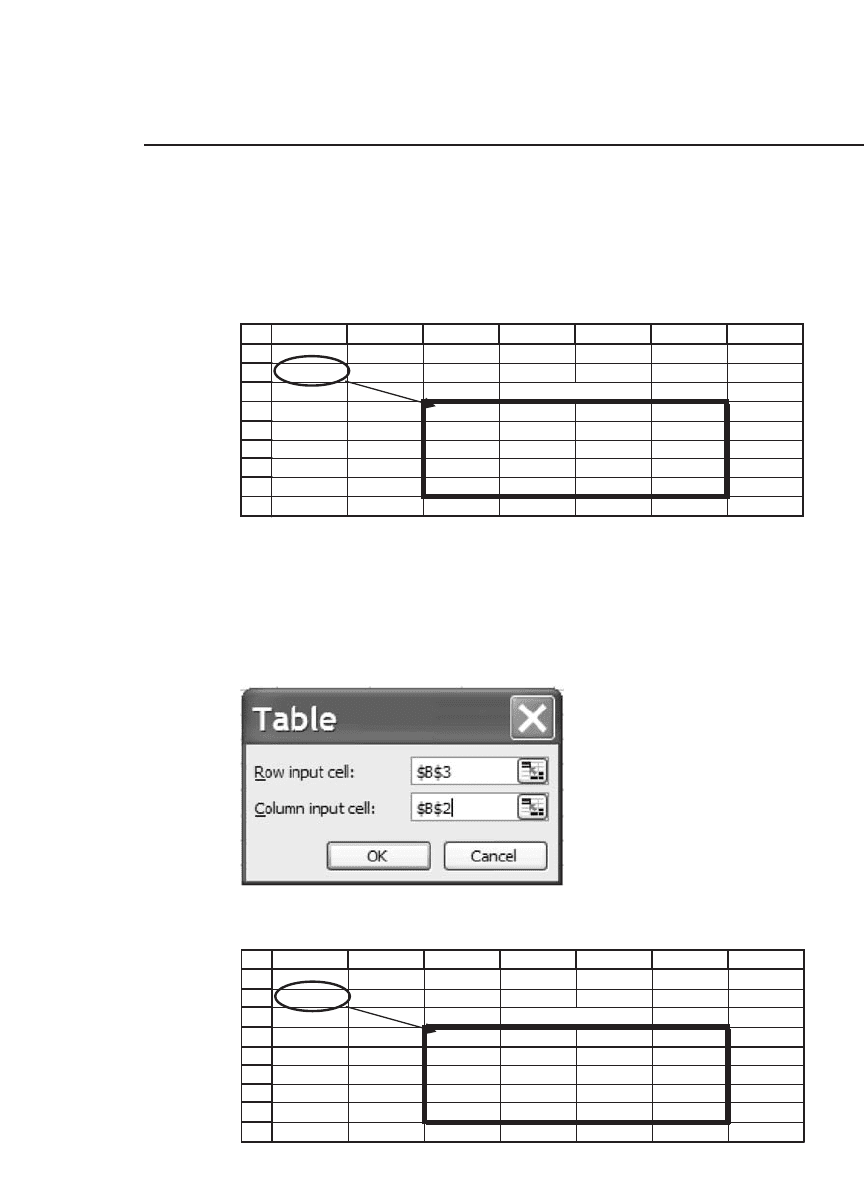
768 Chapter 30
30.4 Building a Two-Dimensional Data Table
We can also use the Data Table command to vary one formula while
changing two parameters. Suppose, for example, that we want to calculate
the net present value (NPV) of the cash fl ows for different growth rates
and different discount rates. We create a new table that looks like this:
19
20
21
22
23
24
25
26
27
EFGH I JK
=B8
Discount rate
101.46 7% 10% 12%
Growth 0
rate 5%
10%
15%
The upper left-hand corner of the table contains the formula “=B8” as a
reference to the basic example.
We now use the Data Table command again. This time we fi ll in both
the Row Input Cell (indicating cell B3, the site of the discount rate in
our basic example) and the Column Input Cell (indicating B2).
19
20
21
22
23
24
25
26
27
EFGH I JK
=B8
Discount rate
101.46 7% 10% 12%
Growth 0 111.09 -10.79 -82.08
rate 5% 297.62 150.74 65.13
10% 515.79 339.09 236.44
15% 770.34 558.25 435.41
Here’s the result:
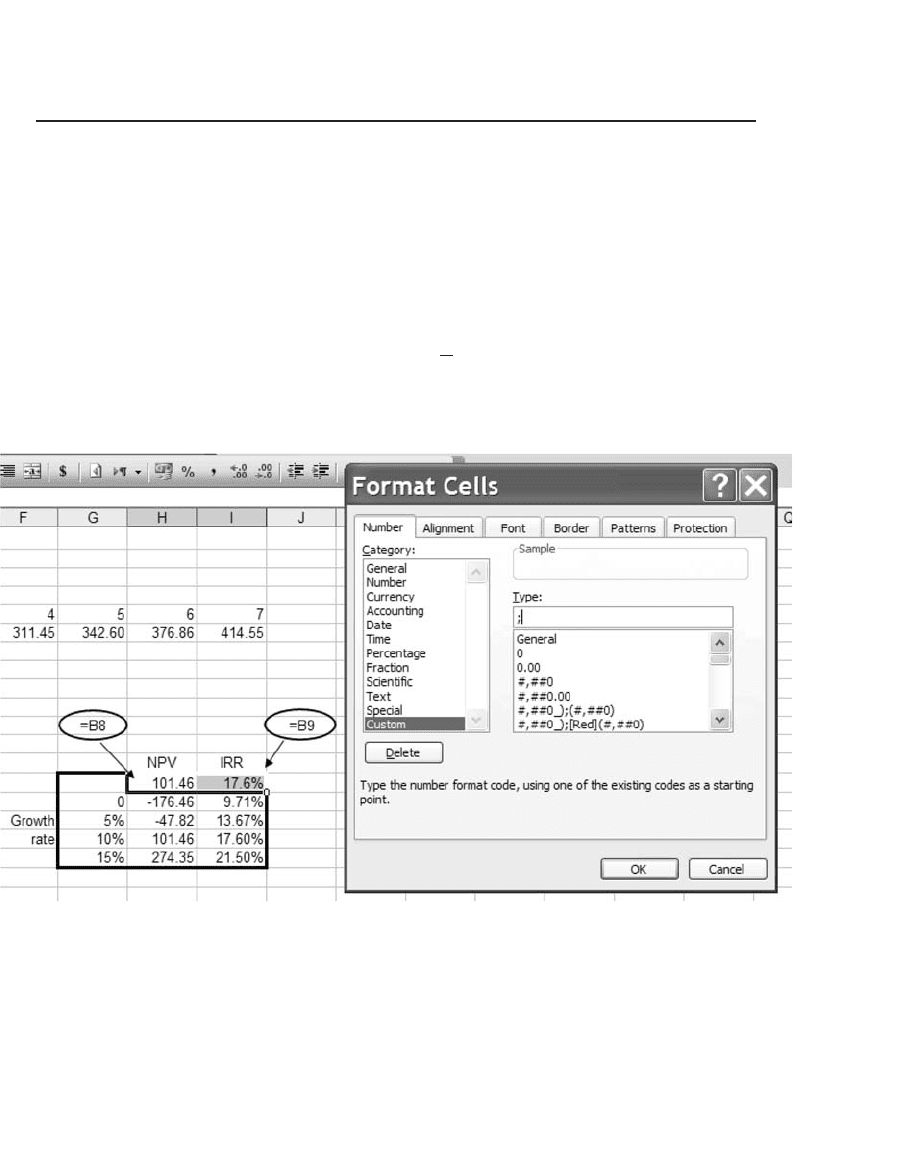
769 Data Tables
30.5 An Aesthetic Note: Hiding the Formula Cells
Data tables tend to look a bit strange, because the formula being calcu-
lated shows up in the data table (in our examples: in the top row of the
fi rst data table and in the left-hand top corner of the second data table).
You can make your tables look nicer by hiding the formula cells. To do
this, mark the offending cells and use the Format Cells command (or
press the right mouse button and go to the Number|Custom). In the
dialogue box go to the box marked Type and insert a semicolon into the
box. Here’s the way this screen looks for the previous example:
The cell contents will now be hidden. The result looks like the
following:
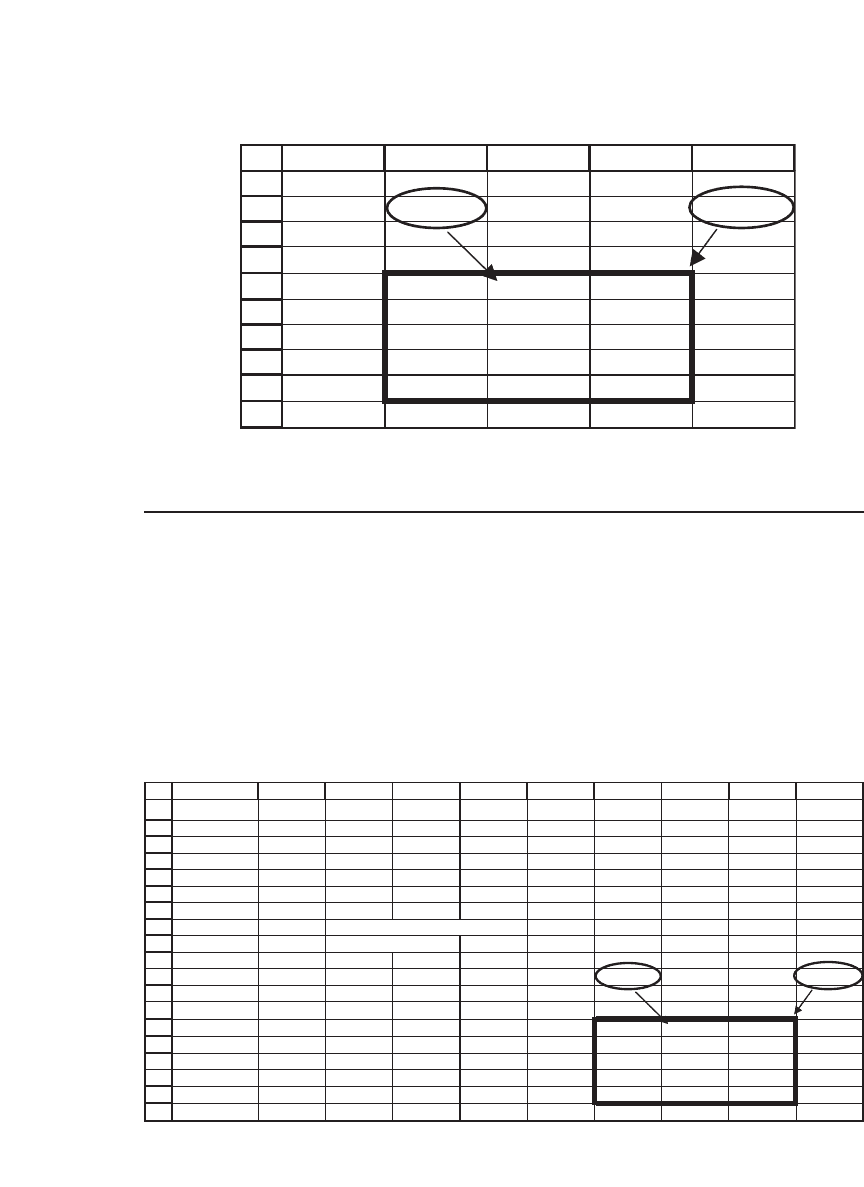
770 Chapter 30
30.6 Excel Data Tables Are Arrays
When we say that Excel data tables are arrays, we mean that they are
dynamically linked to the initial example. When we change a parameter
in the original example, the corresponding column or row of the data
table changes. For example, if we change the initial cash fl ow from 234
to 300, here’s what will happen in the preceding data table:
10
11
12
13
14
15
16
17
18
19
FGH I J
=B8 =B9
NPV IRR
0 -176.46 9.71%
Growth 5% -47.82 13.67%
rate 10% 101.46 17.60%
15% 274.35 21.50%
1
2
3
4
5
6
7
8
9
10
11
12
13
14
15
16
17
18
19
ABCDEFGHIJ
CF
1
300
Growth rate 10%
Discount rate 15%
Year 01234567
Cash flow -1150.00 300.00 330.00 363.00 399.30 439.23 483.15 531.47
NPV 454.43 <
--
=+B6+NPV(B3,C6:I6)
IRR 26.01% <
--
=IRR(B6:I6,0)
=B8 =B9
NPV IRR
0 98.13 17.80%
Growth 5% 263.06 21.92%
rate 10% 454.43 26.01%
15% 676.09 30.07%
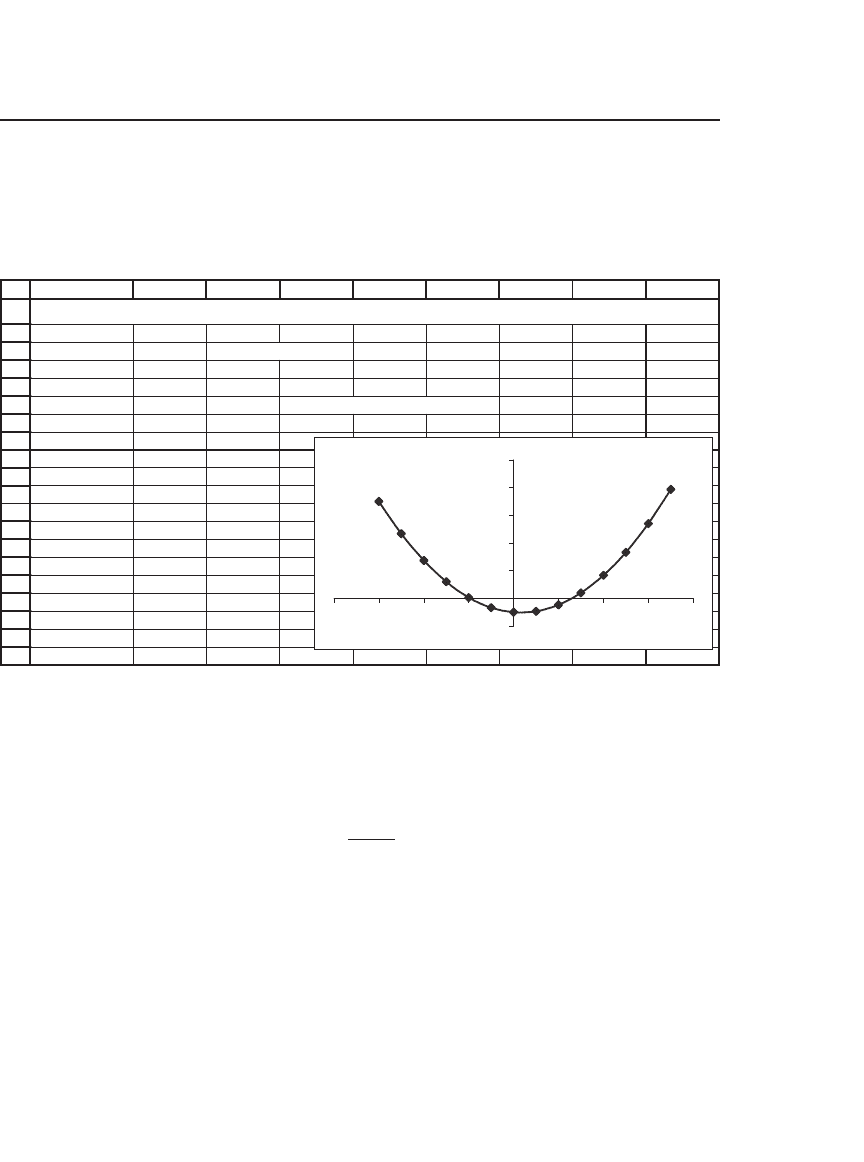
771 Data Tables
Exercises
1. a. Use Data|Table to graph the function f(x) = 3x
2
− 2x − 15, as illustrated in this
spreadsheet:
1
2
3
4
5
6
7
8
9
10
11
12
13
14
15
16
17
18
19
20
ABCDEFGHI
3x
f(x) 6 <
--
=3*B2^2-2*B2-15
x6<
--
=B3, data table header
-6 105
-5 70
-4 41
-3 18
-2 1
-1 -10
0-15
1-14
2-7
36
425
550
681
7118
USING DATA TABLE TO GRAPH A FUNCTION
-30
0
30
60
90
120
150
-8 -6 -4 -2 0 2 4 6 8
b. Use Solver or Goal|Seek to fi nd two values of x, for which f(x) = 0.
2. The Excel function PV(rate, number_periods, payment) calculates the present value
of a constant payment. Thus in the following spreadsheet example,
PV(15 percent, 15, −= =
=
∑
10
10
115
58 47
1
15
)
(. )
.
t
t
(Note that we have put the payment as a negative number, since otherwise Excel
returns a negative value! This little irritation is discussed in Chapters 1 and 33.)
Use Data Table to graph the present value as a function of the discount rate, as
follows:
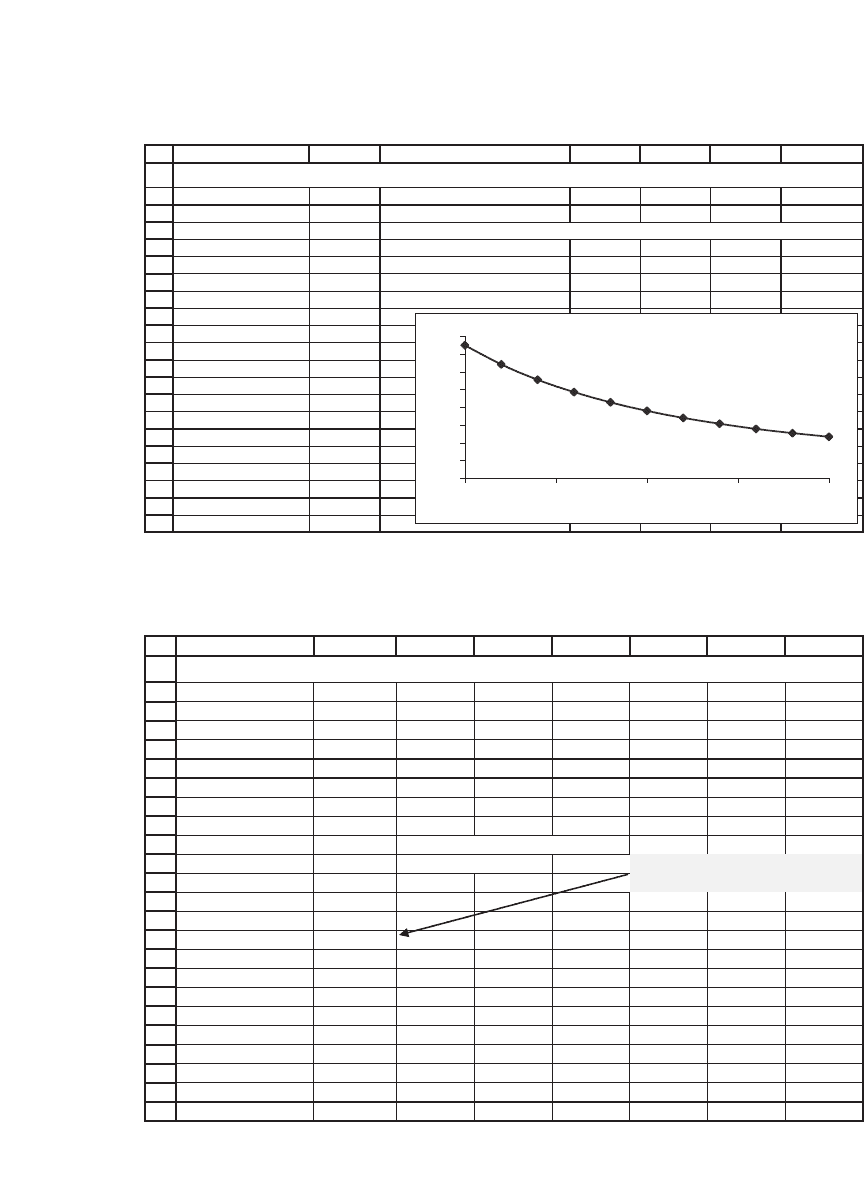
772 Chapter 30
1
2
3
4
5
6
7
8
9
10
11
12
13
14
15
16
17
18
19
20
21
AB C DEFG
15%Rate
Number of periods 15
Payment -10 To get a positive PV, we let the payment be negative (see Chapters 1 & 34)
Present value $58.47 <
--
=PV(B2,B3,B4)
Rate
$58.47 <
--
=B5, data table header
0% 150.00
2% 128.49
4% 111.18
6% 97.12
8% 85.59
10% 76.06
12% 68.11
14% 61.42
16% 55.75
18% 50.92
20% 46.75
DATA TABLE AND PV
0
20
40
60
80
100
120
140
160
0% 5% 10% 15% 20%
3. The following spreadsheet fragment shows a net present value and internal rate of
return calculation for a project:
1
2
3
4
5
6
7
8
9
10
11
12
13
14
15
16
17
18
19
20
21
22
23
24
ABCDEFGH
Growth rate 10%
Discount rate 15%
005tsoC
Year 1 cash flow 100
Year 0 1 2 3 4 5
Cash flow -500.00 100.00 110.00 121.00 133.10 146.41
NPV (101.42) <
--
=NPV(B3,C8:G8)+B8
IRR 6.60% <
--
=IRR(B8:G8)
Growth
($101.42) 0% 3% 6% 9% 12%
0% 0.00 30.91 63.71 98.47 135.28
Discount rate
3% -42.03 -14.56 14.55 45.38 78.01
6% -78.76 -54.26 -28.30 -0.84 28.21
9% -111.03 -89.08 -65.85 -41.28 -15.33
12% -139.52 -119.78 -98.91 -76.86 -53.57
15% -164.78 -146.97 -128.15 -108.28 -87.32
18% -187.28 -171.15 -154.13 -136.16 -117.23
21% -207.40 -192.75 -177.30 -161.01 -143.84
24% -225.46 -212.11 -198.04 -183.22 -167.62
Cell B15 contains the data table
function =B10
NPV, DISCOUNT AND GROWTH RATES

773 Data Tables
Use Data Table to do a sensitivity analysis on the NPV of the project for discount
rates 0, 3, 6, . . . , 21 percent and growth rates 0, 3, . . . , 12 percent.
4. Using Data Table, graph the function sin(x
*
y) for x = 0, 0.2, 0.4, . . . , 1.8, 2 and y =
0, 0.2, 0.4, . . . , 1.8, 2. Use the “Surface” graph option to make a three-dimensional
graph of the function.

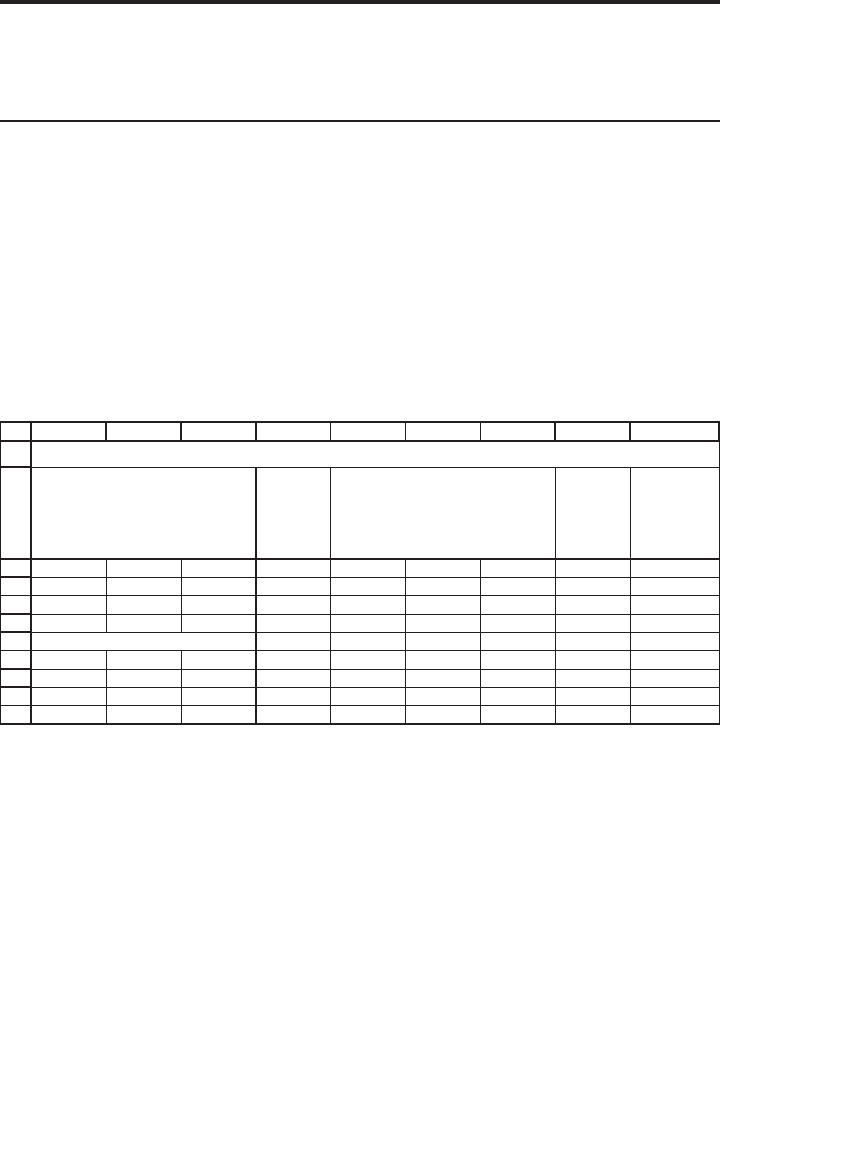
31
Matrices
31.1 Overview
The portfolio optimization chapters of Financial Modeling (Chapters
8–15) make extensive use of matrices to fi nd effi cient portfolios. This
chapter contains enough information about matrices to make it possible
for you to follow the discussion (and do the calculations!) required for
portfolio mathematics.
A matrix is a rectangular array of numbers. All of the following are
matrices:
1
2
3
4
5
6
7
8
9
10
11
ABCDEFGH I
Matrix C
(column
vector)
234 13-8-3
-8 10 -1 -8
-3 -1 11 -3
13 -8 -3
-8 10 -1
-3 -1 11
013 3
Matrix D (a 4 x 3 matrix)
Matrix A (a row vector) Matrix B (square 3 x 3 matrix)
MATRICES IN EXCEL
13
A matrix with only one row is also called a row vector; a matrix with
only one column is also called a column vector. A matrix with an equal
number of rows and columns is called a square matrix.
A single letter is often used to denote a matrix or a vector. In this case
we often write, for example, B = [b
ij
], where b
ij
stands for the entry in
row i and column j of the matrix. For a vector we might write A = [a
i
] or
C = [c
i
]. Thus, for the examples given,
ab c d
322 1 41
4101310=== =
The matrix B is symmetric, meaning that b
ij
= b
ji
. (The variance-
covariance matrices used in the portfolio discussion of Chapters
8–13 are symmetric.)
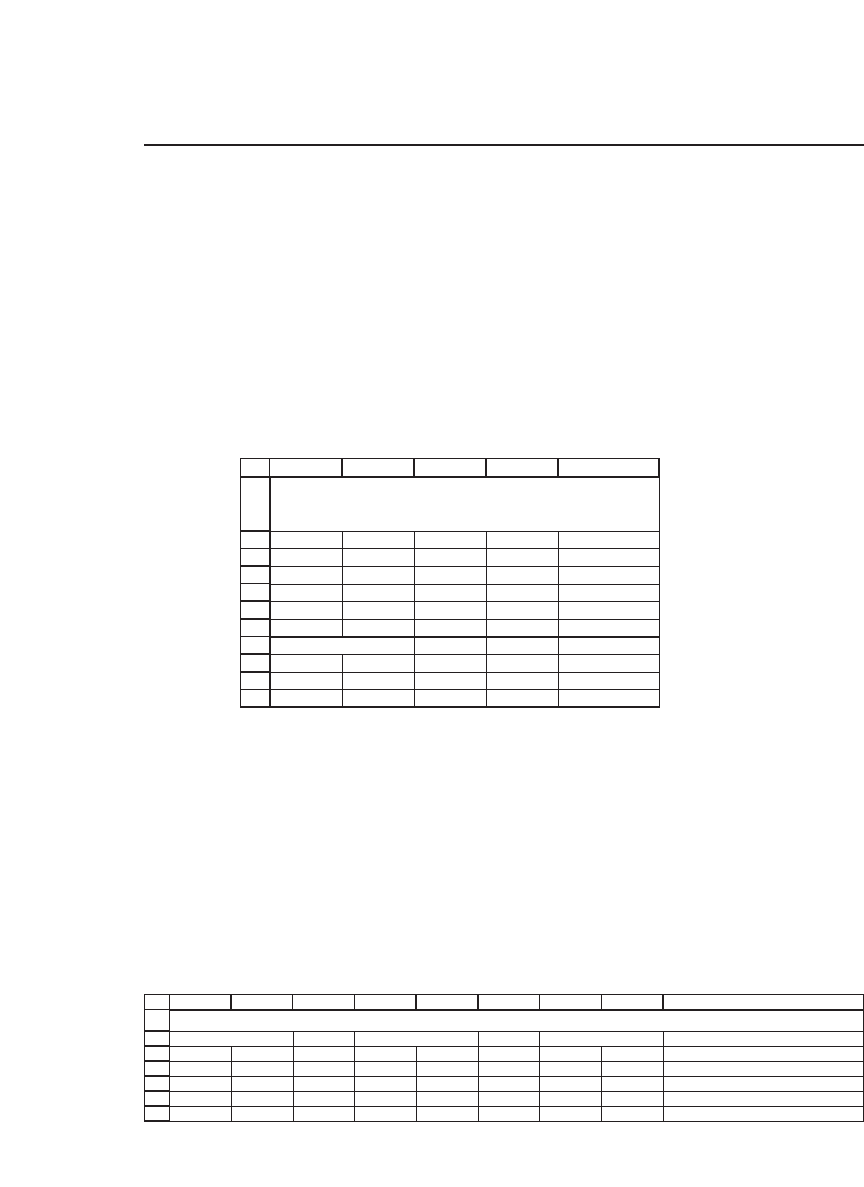
776 Chapter 31
31.2 Matrix Operations
In this section we briefl y review the basic operations on a matrix: multi-
plying a matrix by a scalar, adding matrices, transposition of matrices,
and matrix multiplication.
31.2.1 Multiplication by a Scalar
Multiplying a matrix by a scalar multiplies every entry in the matrix by
the scalar, as in this example:
1
2
3
4
5
6
7
8
9
10
11
ABCD E
Scalar 6
Matrix B 13 -8 -3
-8 10 -1
-3 -1 11
Scalar * Matrix B
78 -48 -18 <
--
=D4*$B$2
-48 60 -6
-18 -6 66
MULTIPLYING A MATRIX BY A SCALAR
31.2.2 Matrix Addition
Matrices may be added together provided they have the same number
of rows and columns. Adding two vectors or matrices is accomplished
by adding their corresponding entries. Thus if A = [a
ij
] and B = [b
ij
],
A + B = [a
ij
+ b
ij
]:
1
2
3
4
5
6
7
ABCDEFGH I
Sum of A + B
1 3 0.1 0 1.1 3 <
--
=B3+E3
30 230 260
6 -9 8 -33.4 14 -42.4
5 11 -15 0 -10 11
7 12 2.33 1.2 9.33 13.2
Matrix A Matrix B
ADDITION OF MATRICES
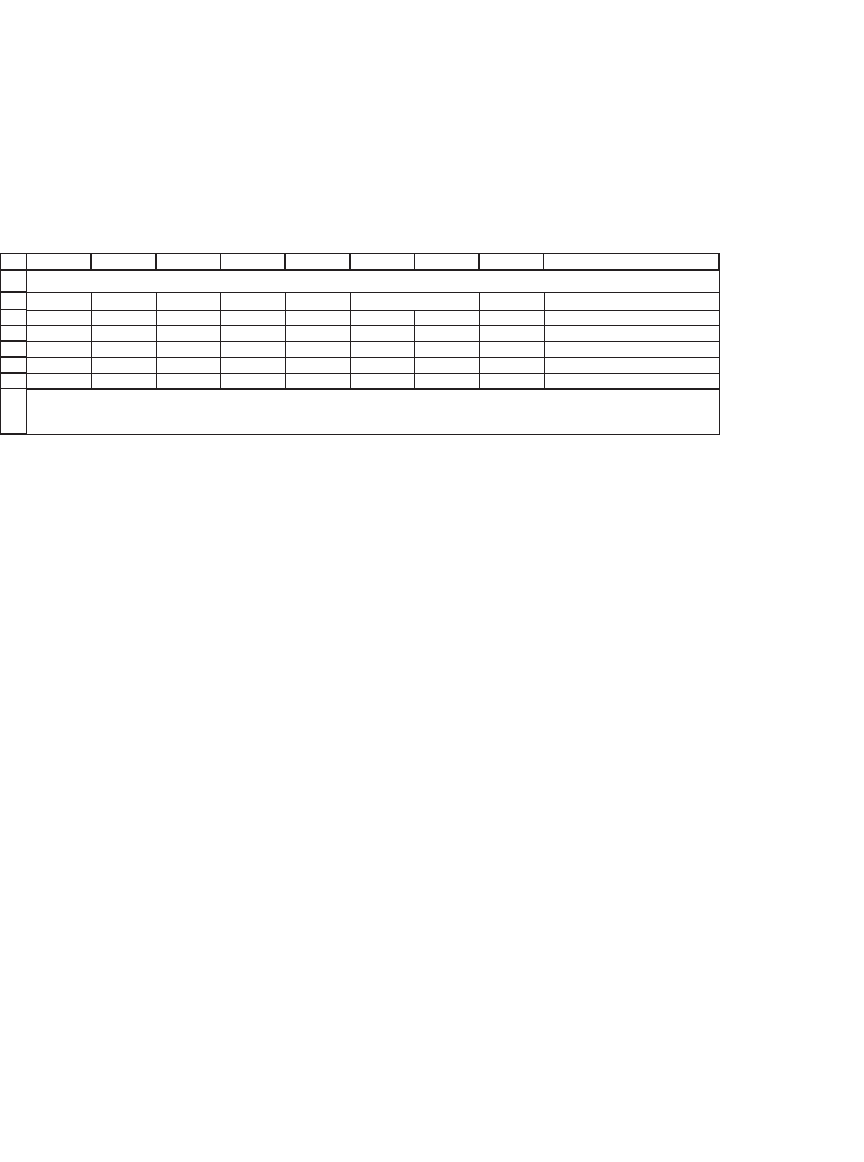
777 Matrices
31.2.3 Matrix Transposition
Transposition is an operation by which the rows of a matrix are turned
into columns and vice versa. Thus for the matrix E:
1
2
3
4
5
6
7
8
ABCDEFGH I
Matrix E
Transpose of E: E
T
1234 1016<
--
{=TRANSPOSE(A3:D5)}
0377-9 237
16 7 7 2 3 77 7
4-9 2
Cells F3:H6 are generated with the array function Transpose(A3:D5). This function is inserted by marking off the target
area, typing the formula, and then finishing by pressing [Ctrl]+[Shift]+[Enter] . See Chapter 34 for more details.
TRANSPOSITION OF MATRICES
This illustration uses the array function Transpose. More details on the
use of array functions are given in Chapter 34.
31.2.4 Multiplication of Matrices
You can multiply matrix A by matrix B to get product AB. However,
you can only do so if the number of columns in A equals the number of
rows in B. The resulting product AB is a matrix with the number of rows
as A and the number of columns of B.
Confused? A couple of examples will help. Suppose that X is a row
vector and that Y is a column vector, both with n coordinates:
XY=
[]
=
⎡
⎣
⎢
⎢
⎢
⎤
⎦
⎥
⎥
⎥
xx
y
y
n
n
1
1
... ,
Then the product of X and Y is defi ned by
XY =
⎡
⎣
⎢
⎢
⎢
⎤
⎦
⎥
⎥
⎥
=
=
∑
[ ... ]xx
y
y
xy
n
n
i
n
ii1
1
1
Now suppose that A and B are two matrices, and that A has n columns
and p rows and B has n rows and m columns:
